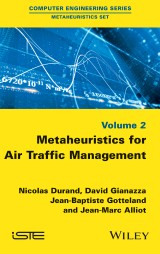Details

Metaheuristics for Air Traffic Management
1. Aufl.
|
139,99 € |
|
| Verlag: | Wiley |
| Format: | |
| Veröffentl.: | 14.12.2015 |
| ISBN/EAN: | 9781119261520 |
| Sprache: | englisch |
| Anzahl Seiten: | 214 |
DRM-geschütztes eBook, Sie benötigen z.B. Adobe Digital Editions und eine Adobe ID zum Lesen.
Beschreibungen
<p>Air Traffic Management involves many different services such as Airspace Management, Air Traffic Flow Management and Air Traffic Control. Many optimization problems arise from these topics and they generally involve different kinds of variables, constraints, uncertainties. Metaheuristics are often good candidates to solve these problems. </p> <p>The book models various complex Air Traffic Management problems such as airport taxiing, departure slot allocation, en route conflict resolution, airspace and route design. The authors detail the operational context and state of art for each problem. They introduce different approaches using metaheuristics to solve these problems and when possible, compare their performances to existing approaches</p>
<p>Introduction ix</p> <p><b>Chapter 1. The Context of Air Traffic Management 1</b></p> <p>1.1. Introduction 1</p> <p>1.2. Vocabulary and units 2</p> <p>1.3. Missions and actors of the air traffic management system 3</p> <p>1.4. Visual flight rules and instrumental flight rules 4</p> <p>1.5. Airspace classes 4</p> <p>1.6. Airspace organization and management 5</p> <p>1.6.1. Flight information regions and functional airspace blocks 5</p> <p>1.6.2. Lower and upper airspace 6</p> <p>1.6.3. Controlled airspace: en route, approach or airport control 7</p> <p>1.6.4. Air route network and airspace sectoring 7</p> <p>1.7. Traffic separation 9</p> <p>1.7.1. Separation standard, loss of separation 9</p> <p>1.7.2. Conflict detection and resolution 11</p> <p>1.7.3. The distribution of tasks among controllers 12</p> <p>1.7.4. The controller tools 12</p> <p>1.8. Traffic regulation 13</p> <p>1.8.1. Capacity and demand 13</p> <p>1.8.2. Workload and air traffic control complexity 15</p> <p>1.9. Airspace management in en route air traffic control centers 16</p> <p>1.9.1. Operating air traffic control sectors in real time 16</p> <p>1.9.2. Anticipating sector openings (France and Europe) 17</p> <p>1.10. Air traffic flow management 19</p> <p>1.11. Research in air traffic management 20</p> <p>1.11.1. The international context 20</p> <p>1.11.2. Research topics 21</p> <p><b>Chapter 2. Air Route Optimization 23</b></p> <p>2.1. Introduction 23</p> <p>2.2. 2D-route network 24</p> <p>2.2.1. Optimal positioning of nodes and edges using geometric algorithms 24</p> <p>2.2.2. Node positioning, with fixed topology, using a simulated annealing or a particle swarm optimization algorithm 28</p> <p>2.2.3. Defining 2D-corridors with a clustering method and a genetic algorithm 29</p> <p>2.3. A network of separate 3D-tubes for the main traffic flows 31</p> <p>2.3.1. A simplified 3D-trajectory model 31</p> <p>2.3.2. Problem formulations and possible strategies 34</p> <p>2.3.3. An A∗ algorithm for the “1 versus n” problem 35</p> <p>2.3.4. A hybrid evolutionary algorithm for the global problem 41</p> <p>2.3.5. Results on a toy problem, with the simplified 3D-trajectory model 50</p> <p>2.3.6. Application to real data, using a more realistic 3D-tube model 57</p> <p>2.4. Conclusion on air route optimization 66</p> <p><b>Chapter 3. Airspace Management 69</b></p> <p>3.1. Airspace sector design 70</p> <p>3.2. Functional airspace block definition 71</p> <p>3.2.1. Simulated annealing algorithm 73</p> <p>3.2.2. Ant colony algorithm 73</p> <p>3.2.3. A fusion–fission method 73</p> <p>3.2.4. Comparison of fusion–fission and classical graph partitioning methods 74</p> <p>3.3. Prediction of air traffic control sector openings 74</p> <p>3.3.1. Problem difficulty and possible approaches 78</p> <p>3.3.2. Using a genetic algorithm 78</p> <p>3.3.3. Tree-search methods, constraint programming 79</p> <p>3.3.4. A neural network for workload prediction 80</p> <p>3.3.5. Conclusion on the prediction of sector openings 83</p> <p><b>Chapter 4. Departure Slot Allocation 85</b></p> <p>4.1. Introduction 85</p> <p>4.2. Context and related works 86</p> <p>4.2.1. Ground holding 86</p> <p>4.3. Conflict-free slot allocation 87</p> <p>4.3.1. Conflict detection 88</p> <p>4.3.2. Sliding forecast time window 90</p> <p>4.3.3. Evolutionary algorithm 91</p> <p>4.4. Results 95</p> <p>4.4.1. Evolution of the problem size 95</p> <p>4.4.2. Numerical results 96</p> <p>4.5. Concluding remarks 98</p> <p><b>Chapter 5. Airport Traffic Management 101</b></p> <p>5.1. Introduction 101</p> <p>5.1.1. Airports’ main challenges 101</p> <p>5.1.2. Known difficulties 102</p> <p>5.1.3. Optimization problems in airport traffic management 103</p> <p>5.2. Gate assignment 103</p> <p>5.2.1. Problem description 103</p> <p>5.2.2. Resolution methods 104</p> <p>5.3. Runway scheduling 106</p> <p>5.3.1. Problem description 106</p> <p>5.3.2. An example of problem formulation 108</p> <p>5.3.3. Resolution methods 109</p> <p>5.4. Surface routing 111</p> <p>5.4.1. Problem description 111</p> <p>5.4.2. Related work 112</p> <p>5.5. Global airport traffic optimization 115</p> <p>5.5.1. Problem description 115</p> <p>5.5.2. Coordination scheme between the different predictive systems 116</p> <p>5.5.3. Simulation results 117</p> <p>5.6. Conclusion 121</p> <p><b>Chapter 6. Conflict Detection and Resolution 123</b></p> <p>6.1. Introduction 123</p> <p>6.2. Conflict resolution complexity 125</p> <p>6.3. Free-flight approaches 128</p> <p>6.3.1. Reactive techniques 129</p> <p>6.3.2. Iterative approach 129</p> <p>6.3.3. An example of reactive approach: neural network trained by evolutionary algorithms 130</p> <p>6.3.4. A limit to autonomous approaches: the speed constraint 137</p> <p>6.4. Iterative approaches 138</p> <p>6.5. Global approaches 138</p> <p>6.6. A global approach using evolutionary computation 140</p> <p>6.6.1. Maneuver modeling 140</p> <p>6.6.2. Uncertainty modeling 141</p> <p>6.6.3. Real-time management 142</p> <p>6.6.4. Evolutionary algorithm implementation 144</p> <p>6.6.5. Alternative modeling 151</p> <p>6.6.6. One-day traffic statistics 152</p> <p>6.6.7. Introducing automation in the existing system 153</p> <p>6.7. A global approach using ant colony optimization 155</p> <p>6.7.1. Problem modeling 155</p> <p>6.7.2. Algorithm description 156</p> <p>6.7.3. Algorithm improvement: constraint relaxation 159</p> <p>6.7.4. Results 160</p> <p>6.7.5. Conclusion and further work 160</p> <p>6.8. A new framework for comparing approaches 163</p> <p>6.8.1. Introduction 163</p> <p>6.8.2. Trajectory prediction model 163</p> <p>6.8.3. Conflict detection 168</p> <p>6.8.4. Benchmark generation 169</p> <p>6.8.5. Conflict resolution 170</p> <p>6.9. Conclusion 177</p> <p>Conclusion 179</p> <p>Bibliography 181</p> <p>Index 193</p>
<p><b>Nicolas Durand</b>, Professor at ENAC (Ecole Nationale de l'Aviation Civile).</p> <p><b>David Gianazza</b>, Assistant Professor at ENAC (Ecole Nationale de l'Aviation Civile).</p> <p><b>Jean-Baptiste Gotteland</b>, Assistant Professor at ENAC (Ecole Nationale de l'Aviation Civile).</p> <p><b>Jean-Marc Alliot</b>, Research Director IRIT (Institut de Recherche en Informatique de Toulouse).</p>
Diese Produkte könnten Sie auch interessieren:

Classification, Parameter Estimation and State Estimation

von: Bangjun Lei, Guangzhu Xu, Ming Feng, Yaobin Zou, Ferdinand van der Heijden, Dick de Ridder, David M. J. Tax

101,99 €
















